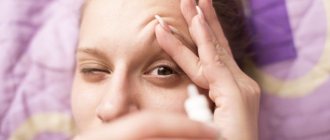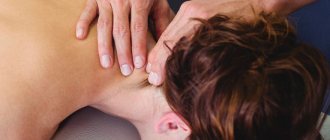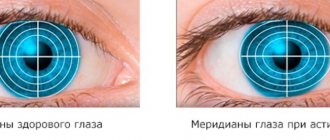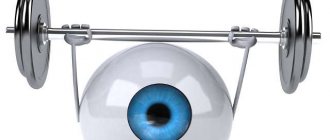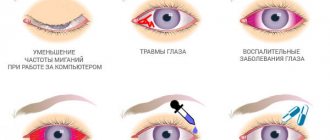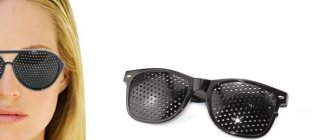These exercises are performed to prevent and correct mild forms of myopia, astigmatism and headaches caused by eye strain.
Acupressure for the eyes
An excellent means of preventing myopia and other vision problems.
Helps recovery after intensive reading and prolonged work at the computer.
It is advisable to do exercises 3-4 times a day.
1. Using bent knuckles, massage the eyebrows and the lower edge of the eye sockets from the center to the outside 30 times.
2. Press with light vibration on the Tung Tzu Liao point (GB-1). Inhaling, increase the pressure, exhaling, release. Perform 30 times.
3. Using the tips of your index and middle fingers, massage the EX-HN4 (YUYAO) points - the skin of the upper eyelid at the level of the middle of the eyebrow. Inhaling, press on them, exhaling, loosen the pressure. Perform 30 times.
4. Use your index and middle fingers to massage the YINTANG point. Inhaling, press on it, exhaling, release the pressure. Perform 30 times.
5. Use your thumbs to massage the Feng Chi points (GB-20). Inhaling, press, exhaling, lower. Perform 30 times.
6. Using your thumb and index finger, massage the Hegu point (LI-4) on each hand. Inhaling, press, exhaling, remove your fingers. Perform 30 times.
Qigong: open and secret methods
For centuries, qigong has been regarded as an ancient Chinese art of healing and self-regulation.
According to this understanding, qigong helped to get rid of diseases, make life long and the physical body strong, strengthen the spirit and understand the world around us in the richness of its phenomena. Since ancient times, qigong has become an organic and obligatory part of Chinese culture, philosophy and, essentially, way of life. Qigong helped in finding peace of mind and in the search for wisdom. For a long time, the practice of qigong was considered secret. At the same time, there were many schools, each with its own methods: clan, family, monastic. Slowly, over hundreds of years, there was an interpenetration, borrowing and mixing of individual elements of these schools. By the middle of the 20th century, qigong practitioners considered only a few areas of qigong, depending on the goals and principles of practice. Yet the subtleties of practice in most areas remained secret.
Medical qigong
The exception was the medical direction of qigong, but only partly. However, even with so little information available, the use of qigong techniques to treat illness and strengthen the body and spirit has been effective. Therefore, the attention of the Western scientific world to him became more intense.
The result of this was the creation of research and treatment centers in the countries of the American continent and Western Europe, as well as the organization of the World Academic Society of Medical Qigong. The healing and healing methods of qigong are gaining increasing popularity to this day and are being studied by science.
Zhong Yuan Qigong: a system for healing
There are areas of qigong that are less known, but the practice of these systems also allows you to become wiser, developed and healthy. Zhong Yuan Qigong also belongs to this direction.
This system is a component of the highest levels of qigong and an integral complex of knowledge and techniques that allow you to normalize your psychophysical state, develop creative abilities, and even master the skills of special abilities. This direction includes elements of many qigong schools, but at the same time it is free from religious overtones and does not pursue ideological goals. This is why anyone can practice Zhong Yuan Qigong, and it will not go against his or her beliefs.
This system is based on elements common to all living organisms: energy channels, biologically active points, yin and yang energy, etc. Mastering the system does not require special changes in diet, rhythm of life or work. It is aimed primarily at improving human health.
Tibetan gymnastics for the eyes: basic exercises
The methods of Tibetan monks are based on the activation of the natural forces of the body, the reserves of which are inexhaustible. By performing exercises that have been practiced for centuries, a modern person can achieve excellent vision, and not only get rid of visual defects. How do Tibetan monks gain super vision? To do this, they practice simple daily exercises.
Exercise "Steps"
The essence of the practice is as follows. You take one step with your eyes open and the next two steps with your eyes closed. You can practice the exercise as many times as you like. After a few days, you will find that you can see better. Why is such a result possible? Because the brain was placed in new conditions (walking blindly) and activated its capabilities. As a result of this, the brain switched to a new mode of perception of the surrounding reality, which resulted in sharpening of vision.
The most interesting thing is that improved vision in this case is just a side effect of the exercise. Walking with closed eyes gives the brain new orientation settings in space, which mobilizes its capabilities. And the result of all this is exactly what you wanted - improved visual perception of the world. You must have someone accompanying you while exercising to prevent accidental falls. Subsequently, you will be able to train on your own, just not on the roadway.
Exercise “Singing Bell”
This practice differs from the previous one in that it is carried out indoors. Buy a Tibetan singing bell that is equal to the diameter of your head. The bell is placed upside down on the practitioner's head and lightly struck with a special wooden stick. The blows should be light so that the vibrations of the metal do not deafen the practitioner. At this moment, the practitioner should slowly rotate his eyeballs to the sides, while looking at the objects around him.
The exercise should be done with both open and closed eyelids. During practice with open eyes, it is necessary to remember objects located in the field of vision, and with closed eyes, try to reproduce them in memory (see with your inner gaze). The practice should not be performed by people with severe diseases of the visual organs - retinal detachment, defects of the optic nerve and damage to the visual centers of the brain.
Important! These practices are designed to develop clairvoyance. However, a pleasant bonus is a significant improvement in physical vision.
Peripheral vision
The essence of the exercise is to observe objects located on the sides. You look at an object in front of you, but at the same time you notice what is located on the sides. This results in a panoramic view.
Take a stick in your hands and extend them in front of you. Look into the distance through the sticks, while noticing their shape and color with your vision. That is, you look into the distance, while simultaneously seeing sticks. Now spread your arms out to the sides, still looking into the distance and watching the chopsticks. Bring your hands together again and continue observing. Repeat the practice 10 times: spread your hands - bring them together - spread them.
Now lower one hand with the stick down, and raise the other up. Continue watching the sticks. Bring your hands together to the starting position - watch the chopsticks. Open your arms again. Repeat the practice 10 times.
Spread your arms diagonally: right up, left down. Bring your hands together. Watch your chopsticks all the time. Repeat the practice 10 times.
Return your hands to the starting position. Now you need to describe circles in front of the sticks with your eyes: 10 times clockwise, 10 times counterclockwise.
Practice with Tibetan table
Tibetan eye gymnastics with a table are performed in a sitting position with a flat and straight back. Print the table on a printer and hang it at a distance of 30 cm from your eyes. All movements during practice should be made only with the eyeballs; you cannot move your head. You need to take off your glasses or contact lenses - they will get in the way. Each exercise should take 30 seconds to complete.
- Palming to relax your eyes. Cup your palms and cover your eyes with them, while crossing your fingers. Sit in silence, let the colorful flashes before your eyes dissolve and a completely black space appears in front of you. Contemplate the blackness for a while, then slowly open your eyelids, blink and lower your palms.
- Rotate your eyeballs clockwise, describing a circle behind the points shown on the table. Execution time is 30 seconds.
- Rotate your eyeballs in the opposite direction - counterclockwise.
- Move your eyes along the diagonal line corresponding to the numbers 2 and 8 on the clock dial.
- Move your eyeballs along the diagonal line corresponding to the numbers 4 and 10 on the clock dial.
- Blink your eyes quickly for a while.
- Finish the exercise with palming practice.
This practice can be performed at any convenient time and as many times as you see fit. The only limitation is to avoid eye strain. If you wear glasses or contacts, reduce the time you use your lenses to a minimum. Soon you will be able to do without auxiliary devices, as your vision will begin to improve every day.
In addition to practice, look at the color green more often. This could be a house plant or trees outside. Green color is very beneficial for the eyes as it activates natural visual power.
Vision treatment and qigong
The eyes are the main organ of perception. It is directly connected to the brain. It is important to maintain functional vision in order to clearly see and perceive phenomena and objects. As the qigong master Yi Zhou notes in his works, based on many years of practice, if you continue training for a long time, this will have a positive effect not only to protect the eyes and increase the power of vision, but also to improve memory, mental abilities, increasing the resistance of the whole body and improving health.
There are three exercises for working with vision in qigong:
- to improve vision;
- for myopia;
- with farsightedness.
How to restore vision: the secret of Chinese emperors
How to restore vision: the secret of Chinese emperors
Elena Gennadievna Fomitsina, a Moscow engineer from the precision engineering design bureau, talks about how you can independently stop the decline in vision with severe myopia and even improve it. Let me introduce myself. I am thirty five years old. I am an engineer. I work with my eyes, although not as intensively as my friend, a programmer. I take vision issues seriously; an ophthalmologist I know calls me a professor and, honestly, listens to my opinion. I consider it my own achievement that my vision indicators have not changed for the last five years, although before that I lost half a diopter every year. Now my minus, which is equal to eight units, remains unchanged. As an adequate person, I, of course, do not believe that such poor vision can be completely corrected. But I am convinced that the restored unit, and two years ago my vision was measured at nine diopters, is not the limit. I'll still fight for a couple of dioptres. I remember well when I decided to purposefully and independently deal with vision problems. This was seven years ago. A friend brought me an article called “Take care of your eyes from the sun.” It spoke very convincingly about the harmful effects of sunlight on vision. It was suggested to use dark glasses at all times. The most convincing argument was the analogy with the harmful effects of the sun on the skin. I not only bought myself dark glasses, but also chose frames with side shields to prevent even the slanting rays of the sun from entering my eyes. But such a coincidence had to happen that literally a month later I attended a lecture at the Polytechnic Museum dedicated to restoring vision using ancient oriental techniques. One of the main pieces of advice turned out to be the following: expose your eyes to the sun as often as possible. In the morning - more intensely, at a time when the sun is at its zenith - no more than a minute. Faced with two mutually exclusive points of view, I went to an ophthalmologist. And I heard a rather honest answer: “There are different opinions. One direction of medicine believes that sunlight provokes a decline in vision and is the cause of early cataracts. Another, widespread in the East and in a number of European countries, claims that the sun is the source of life and has a beneficial effect on vision.” “If the doctor cannot explain it, then I will solve this problem experimentally,” I decided. Actually, I have encountered medical “inconsistency” before. Mom always advised collecting several medical points of view. This is what she did during my school years, until she reached a dead end. I was in high school, and my vision was deteriorating catastrophically. Some doctors argued that it is necessary to constantly wear properly selected glasses. Others advised, if possible, to do without them or use weak glasses so that the eyes were in good shape and constantly working. So, my solar experiment. It was based on the fact that the eyes fail visual balance instantly. Every myopic person knows this. For example, after watching television for a long time or working at the computer, an image appears as if in a fog, the outlines blur, and the eyes turn red. If after a couple of hours the image is restored, then nothing bad happened. Or the opposite example. After a day spent in nature, my eyes were rested and my vision became sharper. Unfortunately, this effect does not last long. I walked around with and without dark glasses, exposing my eyes to the sun's rays at different times of the day. I recorded all the results. Here's what I noticed. If you are in the sun without dark glasses, moreover, often looking at the sun, then in the evening dry eyes appear, and the image glares with bright luminous points, although the quality of vision does not seem to change. But if you look with wide eyes at the sunrise and sunset, the colors become brighter, and your vision clearly improves. Thus, for many years now, in the mornings and evenings, the neighbors from the house opposite are surprised. In any weather, I stand at the open window, and on a clear winter morning I stand in front of the open window and look at the sun for at least five minutes. In the summer, while sunbathing on the beach, I close my eyes, but don’t use dark glasses. Gentle ultraviolet light, penetrating through the curtain of the eyelids, “nourishes” the eye. Tinted glasses are still not useful for weakened eyes. After a day spent wearing dark glasses, your eyes hurt, and all colors lose their brightness and saturation. And if you cover your weakened eyes with dark glasses for several days, photophobia appears. Therefore, I use glasses only in strong southern sun, from which it is impossible to hide my gaze. I think that in the city dark glasses can only be protection from summer dust. The points of view: “the sun is a friend of the eyes” and “the sun as a source of eye problems” are essentially not competing. According to my observations, the “solar truth” is somewhere in the middle of these polar opinions. From the same memorable lecture at the Polytechnic Museum, I learned two useful tips that, it seems to me, helped me stop the progression of myopia. So, two pieces of advice from the Chinese emperors:
- Use the tips of your index fingers to massage the points at the inner corners of the eye. You need to continue the massage until a smooth black field appears under your closed eyelids.
- All points responsible for vision are located on the earlobe. Therefore, grab your earlobe with your thumb and forefinger and knead it for 10 seconds. This massage must be repeated at least five times. During pauses, try moving your ears, although not everyone succeeds. The result of this massage is immediate - fatigue is relieved, it feels like the eye begins to breathe actively and is abundantly washed with tears.
By the way, about the tear. I have long noticed that before my eyes encounter any abnormality: conjunctivitis, inflammation, fogginess, they become dry. They lack pure tears. In such cases, I try to wash the cornea. I “rinse” drooping eyes in a weak solution of green tea or simply in clean boiled water at room temperature and drop several pipettes of sterile saline solution into the eyes. Well, I was convinced of the benefits of gymnastics for the eyes by the example of my daughter. The baby was born without a reserve of farsightedness, that is, with hereditary myopia. Inherited my problems. I went to school with a minus one. We did and continue to do exercises not just three times a day, but thirty-three. The fact that, having been diagnosed with “hereditary myopia,” my daughter, who is now in the eighth grade, not only retained her vision, but also corrected her myopia, is the biggest victory in my life. We did a variety of exercises, which are recommended by modern ophthalmology. By yoga and by Dr. Bates. Using a stopwatch, they verified the correctness of strict European eye gymnastics: hold your gaze on a distant object for 7 seconds, and then look at a nearby object for 3 seconds. I came to the conclusion that all methods of eye exercises are initially based on the same principles of training the eye muscles. And how many seconds and in which direction you look does not matter. Another observation concerns diet. Strong alcoholic drinks have the most adverse effect on myopic people. Be sure to eat one type from the list of vegetables and fruits that are good for vision once a day. There are, in fact, only ten of them: blueberries, apricots, rose hips, hawthorn, carrots, beets, pumpkin, sauerkraut, parsley and green onions. Every day your diet should include one serving of beef liver or cod liver, freshly cooked buckwheat porridge or a dessert spoon of honey. Give it a try. It helped me. Punctuality, perseverance, faith in success. Exercise for the eyes
- Rotate your eyes, both clockwise and counterclockwise.
- Sharp movement of the eyes horizontally and vertically.
- Bringing the eyes to the bridge of the nose.
- Frequent blinking.
- Shifting the gaze from a near object to a distant one.
04/12/2020 10:25:56 am
04/12/2020 02:36:38 pm
Med-Apparatus
Med-Apparatus
Med-Apparatus medical devices and physiotherapy. Medical equipment bulletin board.
Russia
Med-Apparatus medical devices and physiotherapy. Medical equipment bulletin board.
Qigong to improve vision
These exercises, in fact, constitute a set of techniques. So, after the Big Tree - this is an ancient exercise that is performed on slightly bent knees for at least half an hour - intensively rub your palms, fold them into a boat and close your eyes so that the Laogong points (the point on the palm where the nail of the middle finger rests when bent) to the center of the palm) were located opposite the pupils.
Feel the warmth emanating from the center of your palms to the eye area. Similarly, the eyes are fed with their own energy after the “Qi Transformation” exercise (visualization of an energy ball in the lower diantian). It is also recommended to repeat this procedure several times a day after vigorously rubbing your palms until they become hot.
Qigong for the eyes - methods of Beijing traditional Chinese medicine clinics
These exercises are performed to prevent and correct mild forms of myopia, astigmatism and headaches caused by eye strain.
These exercises should not be performed if you have high blood pressure or glaucoma.
1. Rise of pure yang energy to the eyes. This exercise directs the flow of qi through the liver meridian to the eyes.
Close your eyes, relax and mentally direct the chi from point LV1 up the shin and inner thigh and further along the stomach to point LV14. Continue to move the chi up your throat to your eyes. In this case, your eyes should be wide open, your gaze directed at an object located two to three meters away from you. Imagine how yang qi dispels the fog in your eyes.
2. Activation of qi and blood. It helps direct qi and blood directly to the eyes through special eye movements.
Close your eyes and relax your body. Place your eyes on the bridge of your nose, then move them outward, look up, left, right. After this, rotate your eyes in a circle - first from left to right, then from right to left.
3. Change of focus. Close your eyes and relax. Raise your eyelids and fix your gaze on some distant object for 60 seconds. Then begin to gradually close your eyes until you see your own nose. When your eyes “converge on the bridge of your nose,” close them. Then alternately open your left and then your right eye (repeat 6 times - eyes are closed all the time).
When you look from a distant object to your own nose, try not to blink. Try to go slower each time. If you experience burning or itching sensations in your eyes, do not be alarmed - this is a normal phenomenon associated with improved circulation of energy and blood in the eyes.
4. Acupressure along the posteromedial meridian. During this exercise, energy is directed to the fingertips and through them to the acupuncture points that you massage.
Close your eyes and relax. Direct the flow of chi into your index fingers, focusing on them and feeling the warmth, tingling, tension in them. First, press the baihui and yintang points simultaneously, imagining the qi flowing down the posteromedial meridian to the yintang point. Then massage the acupuncture points around the eyes - yin-tang, jianzhu, yuyao, sizhukong, tongzilyao, qihou, chengqi, jingming - starting from the inner corners of the eyes and in a circle. Stimulate points in both eyes at the same time.
Having completed the circle, continue to direct the flow of qi down the posteromedial meridian, through the yingxiang and renzhong points to the diantian.
After finishing this set of exercises, close your eyes for a while and relax. Focus your attention on the lower diantian. You can repeat this complex 10-20 times. A feeling of discomfort and flashing of colored spots before the eyes is normal when performing exercises.
Qigong for myopia
Myopia is due to the fact that the lens has an excessively convex shape, and then the focal length is too short. If the causes of myopia are only this, then for treatment the palms are rubbed until hot, then the eyes are closed with a “boat” and you imagine that the qi emanating from the palms flattens the lens of the eye. Try to mentally consolidate this effect.
This technique is effective in treating children who have developed myopia not too long ago. But the causes of myopia are different. If after efforts the problems do not go away, find out what is causing it. For example, deterioration of vision is not a consequence of eye diseases, but of diseases of other organs. Thus, the eyes are not active enough if the liver or spleen is dysfunctional. In this case, pain in certain areas of the spine is likely. Then the treatment is complex: the liver and spleen should be treated simultaneously.
